STEM Unit Plan: Week 1 - Addition, Subtraction, and Measurement
VerifiedAdded on 2022/08/14
|7
|1875
|18
Homework Assignment
AI Summary
This document presents a comprehensive STEM unit plan designed for 2nd-grade students, focusing on the core mathematical concepts of addition, subtraction, and measurement. The plan spans four days, with each day building upon the previous one to reinforce understanding and application. The lessons integrate state and national standards, including Arizona Mathematics Standards and ISTE Student Technology Standards, ensuring alignment with educational objectives. The activities include hands-on exercises using objects, interactive iPad applications, and worksheets, catering to diverse learning styles. Students will learn to solve word problems, understand place value, and apply addition and subtraction in the context of measuring length. The unit also emphasizes the use of digital tools and collaborative group work to enhance learning and promote inclusivity. Formative assessment strategies are integrated throughout the lessons to monitor student progress, culminating in a summative assessment that evaluates their understanding of the key numeracy skills. The plan incorporates differentiation strategies to support students with special needs, fostering a holistic approach to learning and development.

STEM Unit Plan Template
Week 1 Day 1 Day 2 Day 3 Day 4
Lesson Title Addition and
Subtraction.
Differentiating 10, 100
and 1000 as groups of
10.
Use addition and
subtraction for
measuring length
Practice day for testing
counting and
measurement.
Brief Summary
and Rationale
Here the students will
be learning about how
to use addition and
subtraction to and
from a number to
reach another number.
Addition and
subtraction are
primary requisites for
financial numeracy
development. It is
therefore also
identified in the state
standards.
Here the students will
learn about how 100
and 1000 are just
groups of 10.
Understanding group
based counting allows
the student to count
faster and easier. This
develops counting
based numeracy skills
in significant ways.
Here the students will
implement their
knowledge of addition
and subtraction in the
context of measurement.
They will add numbers
to existing lengths to
measure the difference
in lengths.
The students will reflect
upon their engagement
in the past three days
and successfully
implement their learning
in a practical context.
State/National Arizona State Arizona State Arizona State Arizona State
© 2024. Grand Canyon University. All Rights Reserved.
Week 1 Day 1 Day 2 Day 3 Day 4
Lesson Title Addition and
Subtraction.
Differentiating 10, 100
and 1000 as groups of
10.
Use addition and
subtraction for
measuring length
Practice day for testing
counting and
measurement.
Brief Summary
and Rationale
Here the students will
be learning about how
to use addition and
subtraction to and
from a number to
reach another number.
Addition and
subtraction are
primary requisites for
financial numeracy
development. It is
therefore also
identified in the state
standards.
Here the students will
learn about how 100
and 1000 are just
groups of 10.
Understanding group
based counting allows
the student to count
faster and easier. This
develops counting
based numeracy skills
in significant ways.
Here the students will
implement their
knowledge of addition
and subtraction in the
context of measurement.
They will add numbers
to existing lengths to
measure the difference
in lengths.
The students will reflect
upon their engagement
in the past three days
and successfully
implement their learning
in a practical context.
State/National Arizona State Arizona State Arizona State Arizona State
© 2024. Grand Canyon University. All Rights Reserved.
Paraphrase This Document
Need a fresh take? Get an instant paraphrase of this document with our AI Paraphraser
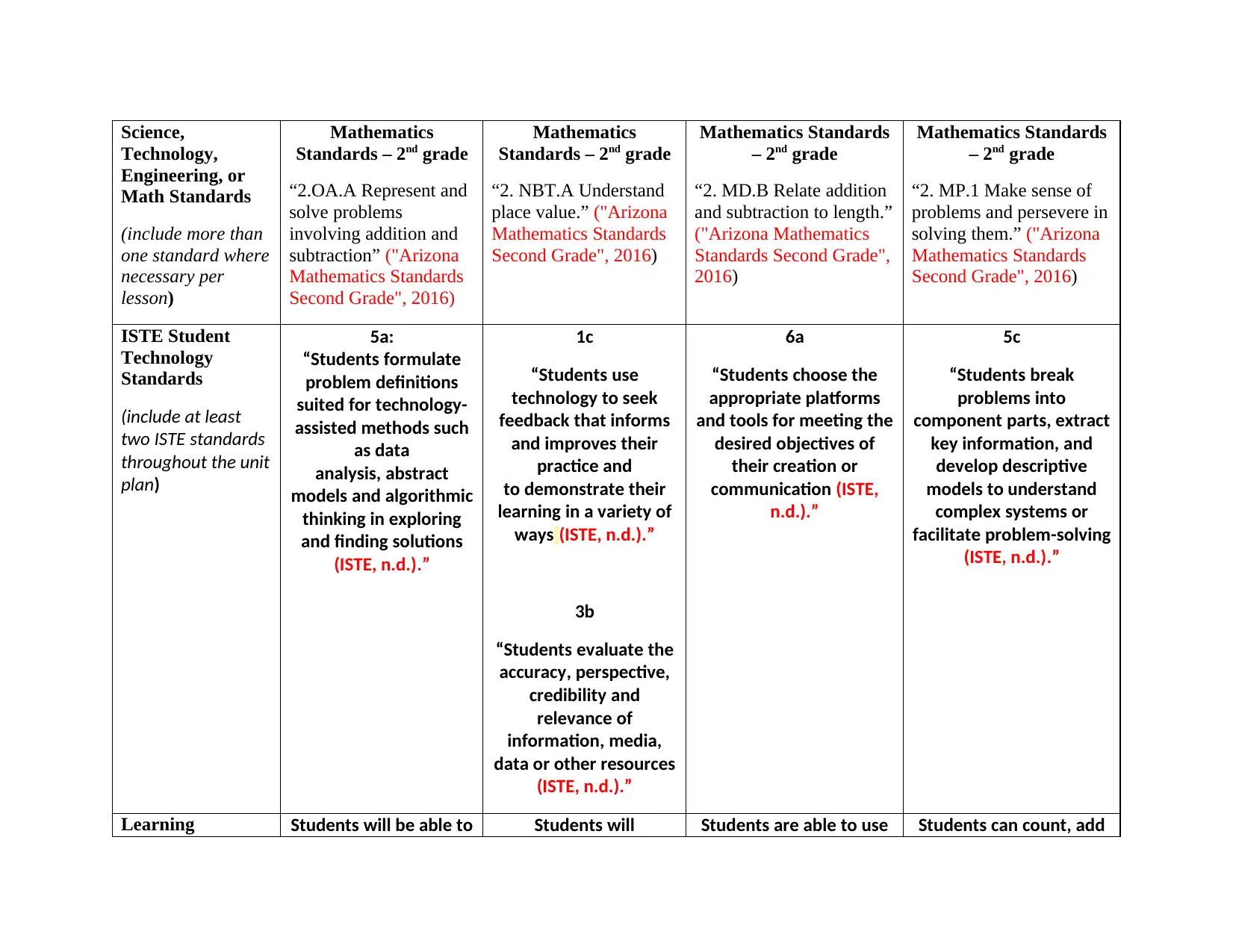
Science,
Technology,
Engineering, or
Math Standards
(include more than
one standard where
necessary per
lesson)
Mathematics
Standards – 2nd grade
“2.OA.A Represent and
solve problems
involving addition and
subtraction” ("Arizona
Mathematics Standards
Second Grade", 2016)
Mathematics
Standards – 2nd grade
“2. NBT.A Understand
place value.” ("Arizona
Mathematics Standards
Second Grade", 2016)
Mathematics Standards
– 2nd grade
“2. MD.B Relate addition
and subtraction to length.”
("Arizona Mathematics
Standards Second Grade",
2016)
Mathematics Standards
– 2nd grade
“2. MP.1 Make sense of
problems and persevere in
solving them.” ("Arizona
Mathematics Standards
Second Grade", 2016)
ISTE Student
Technology
Standards
(include at least
two ISTE standards
throughout the unit
plan)
5a:
“Students formulate
problem definitions
suited for technology-
assisted methods such
as data
analysis, abstract
models and algorithmic
thinking in exploring
and finding solutions
(ISTE, n.d.).”
1c
“Students use
technology to seek
feedback that informs
and improves their
practice and
to demonstrate their
learning in a variety of
ways (ISTE, n.d.).”
3b
“Students evaluate the
accuracy, perspective,
credibility and
relevance of
information, media,
data or other resources
(ISTE, n.d.).”
6a
“Students choose the
appropriate platforms
and tools for meeting the
desired objectives of
their creation or
communication (ISTE,
n.d.).”
5c
“Students break
problems into
component parts, extract
key information, and
develop descriptive
models to understand
complex systems or
facilitate problem-solving
(ISTE, n.d.).”
Learning Students will be able to Students will Students are able to use Students can count, add
Technology,
Engineering, or
Math Standards
(include more than
one standard where
necessary per
lesson)
Mathematics
Standards – 2nd grade
“2.OA.A Represent and
solve problems
involving addition and
subtraction” ("Arizona
Mathematics Standards
Second Grade", 2016)
Mathematics
Standards – 2nd grade
“2. NBT.A Understand
place value.” ("Arizona
Mathematics Standards
Second Grade", 2016)
Mathematics Standards
– 2nd grade
“2. MD.B Relate addition
and subtraction to length.”
("Arizona Mathematics
Standards Second Grade",
2016)
Mathematics Standards
– 2nd grade
“2. MP.1 Make sense of
problems and persevere in
solving them.” ("Arizona
Mathematics Standards
Second Grade", 2016)
ISTE Student
Technology
Standards
(include at least
two ISTE standards
throughout the unit
plan)
5a:
“Students formulate
problem definitions
suited for technology-
assisted methods such
as data
analysis, abstract
models and algorithmic
thinking in exploring
and finding solutions
(ISTE, n.d.).”
1c
“Students use
technology to seek
feedback that informs
and improves their
practice and
to demonstrate their
learning in a variety of
ways (ISTE, n.d.).”
3b
“Students evaluate the
accuracy, perspective,
credibility and
relevance of
information, media,
data or other resources
(ISTE, n.d.).”
6a
“Students choose the
appropriate platforms
and tools for meeting the
desired objectives of
their creation or
communication (ISTE,
n.d.).”
5c
“Students break
problems into
component parts, extract
key information, and
develop descriptive
models to understand
complex systems or
facilitate problem-solving
(ISTE, n.d.).”
Learning Students will be able to Students will Students are able to use Students can count, add
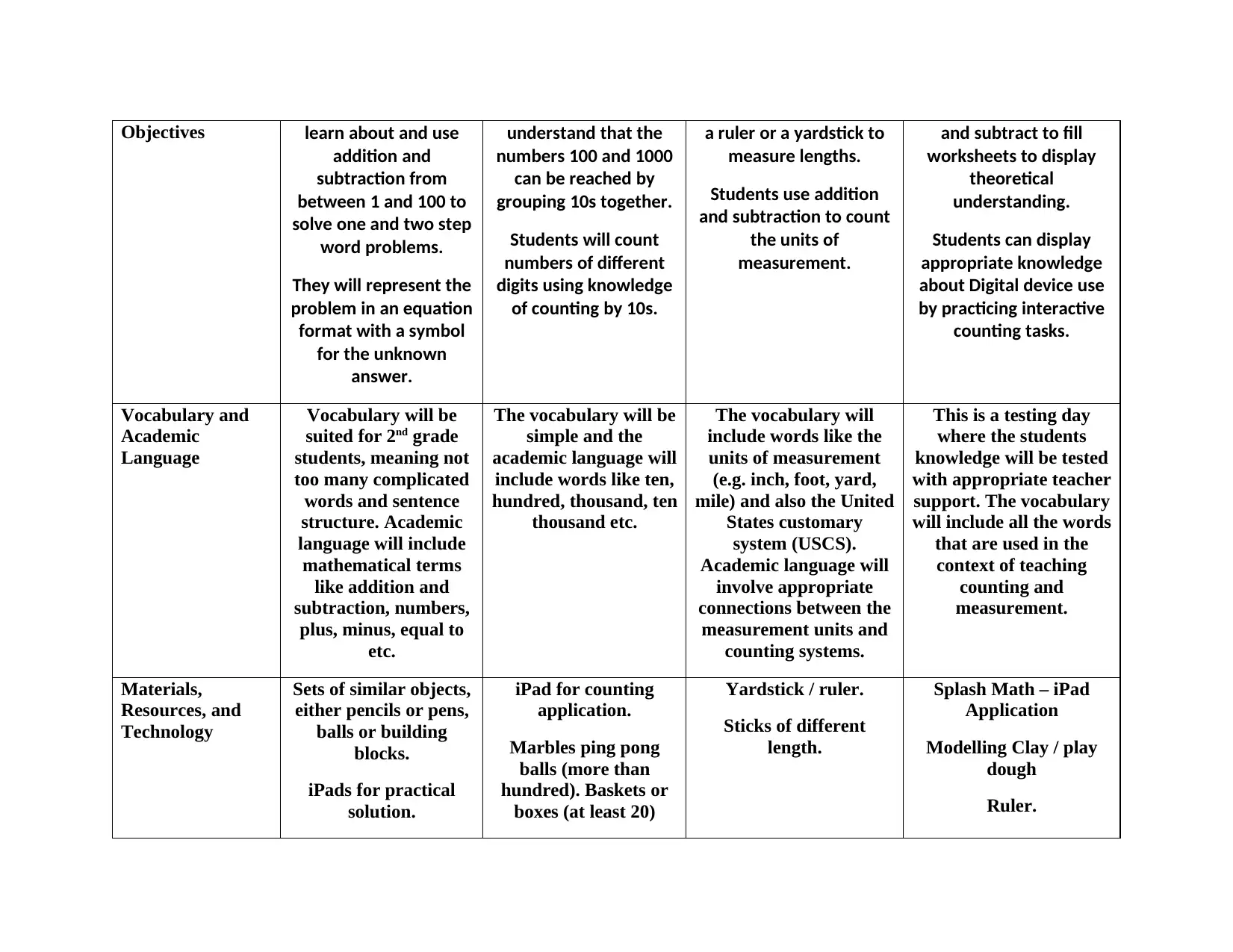
Objectives learn about and use
addition and
subtraction from
between 1 and 100 to
solve one and two step
word problems.
They will represent the
problem in an equation
format with a symbol
for the unknown
answer.
understand that the
numbers 100 and 1000
can be reached by
grouping 10s together.
Students will count
numbers of different
digits using knowledge
of counting by 10s.
a ruler or a yardstick to
measure lengths.
Students use addition
and subtraction to count
the units of
measurement.
and subtract to fill
worksheets to display
theoretical
understanding.
Students can display
appropriate knowledge
about Digital device use
by practicing interactive
counting tasks.
Vocabulary and
Academic
Language
Vocabulary will be
suited for 2nd grade
students, meaning not
too many complicated
words and sentence
structure. Academic
language will include
mathematical terms
like addition and
subtraction, numbers,
plus, minus, equal to
etc.
The vocabulary will be
simple and the
academic language will
include words like ten,
hundred, thousand, ten
thousand etc.
The vocabulary will
include words like the
units of measurement
(e.g. inch, foot, yard,
mile) and also the United
States customary
system (USCS).
Academic language will
involve appropriate
connections between the
measurement units and
counting systems.
This is a testing day
where the students
knowledge will be tested
with appropriate teacher
support. The vocabulary
will include all the words
that are used in the
context of teaching
counting and
measurement.
Materials,
Resources, and
Technology
Sets of similar objects,
either pencils or pens,
balls or building
blocks.
iPads for practical
solution.
iPad for counting
application.
Marbles ping pong
balls (more than
hundred). Baskets or
boxes (at least 20)
Yardstick / ruler.
Sticks of different
length.
Splash Math – iPad
Application
Modelling Clay / play
dough
Ruler.
addition and
subtraction from
between 1 and 100 to
solve one and two step
word problems.
They will represent the
problem in an equation
format with a symbol
for the unknown
answer.
understand that the
numbers 100 and 1000
can be reached by
grouping 10s together.
Students will count
numbers of different
digits using knowledge
of counting by 10s.
a ruler or a yardstick to
measure lengths.
Students use addition
and subtraction to count
the units of
measurement.
and subtract to fill
worksheets to display
theoretical
understanding.
Students can display
appropriate knowledge
about Digital device use
by practicing interactive
counting tasks.
Vocabulary and
Academic
Language
Vocabulary will be
suited for 2nd grade
students, meaning not
too many complicated
words and sentence
structure. Academic
language will include
mathematical terms
like addition and
subtraction, numbers,
plus, minus, equal to
etc.
The vocabulary will be
simple and the
academic language will
include words like ten,
hundred, thousand, ten
thousand etc.
The vocabulary will
include words like the
units of measurement
(e.g. inch, foot, yard,
mile) and also the United
States customary
system (USCS).
Academic language will
involve appropriate
connections between the
measurement units and
counting systems.
This is a testing day
where the students
knowledge will be tested
with appropriate teacher
support. The vocabulary
will include all the words
that are used in the
context of teaching
counting and
measurement.
Materials,
Resources, and
Technology
Sets of similar objects,
either pencils or pens,
balls or building
blocks.
iPads for practical
solution.
iPad for counting
application.
Marbles ping pong
balls (more than
hundred). Baskets or
boxes (at least 20)
Yardstick / ruler.
Sticks of different
length.
Splash Math – iPad
Application
Modelling Clay / play
dough
Ruler.
⊘ This is a preview!⊘
Do you want full access?
Subscribe today to unlock all pages.

Trusted by 1+ million students worldwide
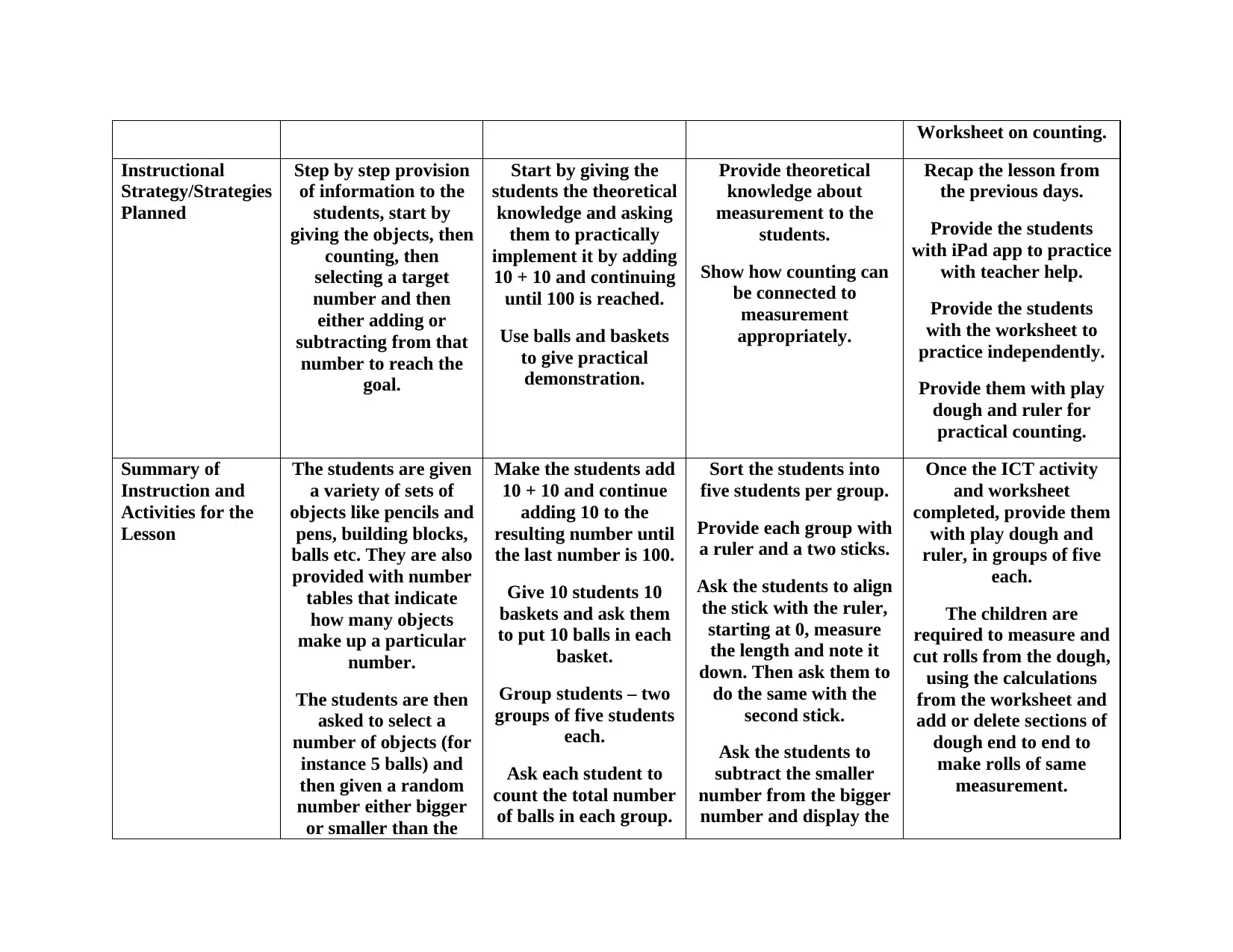
Worksheet on counting.
Instructional
Strategy/Strategies
Planned
Step by step provision
of information to the
students, start by
giving the objects, then
counting, then
selecting a target
number and then
either adding or
subtracting from that
number to reach the
goal.
Start by giving the
students the theoretical
knowledge and asking
them to practically
implement it by adding
10 + 10 and continuing
until 100 is reached.
Use balls and baskets
to give practical
demonstration.
Provide theoretical
knowledge about
measurement to the
students.
Show how counting can
be connected to
measurement
appropriately.
Recap the lesson from
the previous days.
Provide the students
with iPad app to practice
with teacher help.
Provide the students
with the worksheet to
practice independently.
Provide them with play
dough and ruler for
practical counting.
Summary of
Instruction and
Activities for the
Lesson
The students are given
a variety of sets of
objects like pencils and
pens, building blocks,
balls etc. They are also
provided with number
tables that indicate
how many objects
make up a particular
number.
The students are then
asked to select a
number of objects (for
instance 5 balls) and
then given a random
number either bigger
or smaller than the
Make the students add
10 + 10 and continue
adding 10 to the
resulting number until
the last number is 100.
Give 10 students 10
baskets and ask them
to put 10 balls in each
basket.
Group students – two
groups of five students
each.
Ask each student to
count the total number
of balls in each group.
Sort the students into
five students per group.
Provide each group with
a ruler and a two sticks.
Ask the students to align
the stick with the ruler,
starting at 0, measure
the length and note it
down. Then ask them to
do the same with the
second stick.
Ask the students to
subtract the smaller
number from the bigger
number and display the
Once the ICT activity
and worksheet
completed, provide them
with play dough and
ruler, in groups of five
each.
The children are
required to measure and
cut rolls from the dough,
using the calculations
from the worksheet and
add or delete sections of
dough end to end to
make rolls of same
measurement.
Instructional
Strategy/Strategies
Planned
Step by step provision
of information to the
students, start by
giving the objects, then
counting, then
selecting a target
number and then
either adding or
subtracting from that
number to reach the
goal.
Start by giving the
students the theoretical
knowledge and asking
them to practically
implement it by adding
10 + 10 and continuing
until 100 is reached.
Use balls and baskets
to give practical
demonstration.
Provide theoretical
knowledge about
measurement to the
students.
Show how counting can
be connected to
measurement
appropriately.
Recap the lesson from
the previous days.
Provide the students
with iPad app to practice
with teacher help.
Provide the students
with the worksheet to
practice independently.
Provide them with play
dough and ruler for
practical counting.
Summary of
Instruction and
Activities for the
Lesson
The students are given
a variety of sets of
objects like pencils and
pens, building blocks,
balls etc. They are also
provided with number
tables that indicate
how many objects
make up a particular
number.
The students are then
asked to select a
number of objects (for
instance 5 balls) and
then given a random
number either bigger
or smaller than the
Make the students add
10 + 10 and continue
adding 10 to the
resulting number until
the last number is 100.
Give 10 students 10
baskets and ask them
to put 10 balls in each
basket.
Group students – two
groups of five students
each.
Ask each student to
count the total number
of balls in each group.
Sort the students into
five students per group.
Provide each group with
a ruler and a two sticks.
Ask the students to align
the stick with the ruler,
starting at 0, measure
the length and note it
down. Then ask them to
do the same with the
second stick.
Ask the students to
subtract the smaller
number from the bigger
number and display the
Once the ICT activity
and worksheet
completed, provide them
with play dough and
ruler, in groups of five
each.
The children are
required to measure and
cut rolls from the dough,
using the calculations
from the worksheet and
add or delete sections of
dough end to end to
make rolls of same
measurement.
Paraphrase This Document
Need a fresh take? Get an instant paraphrase of this document with our AI Paraphraser
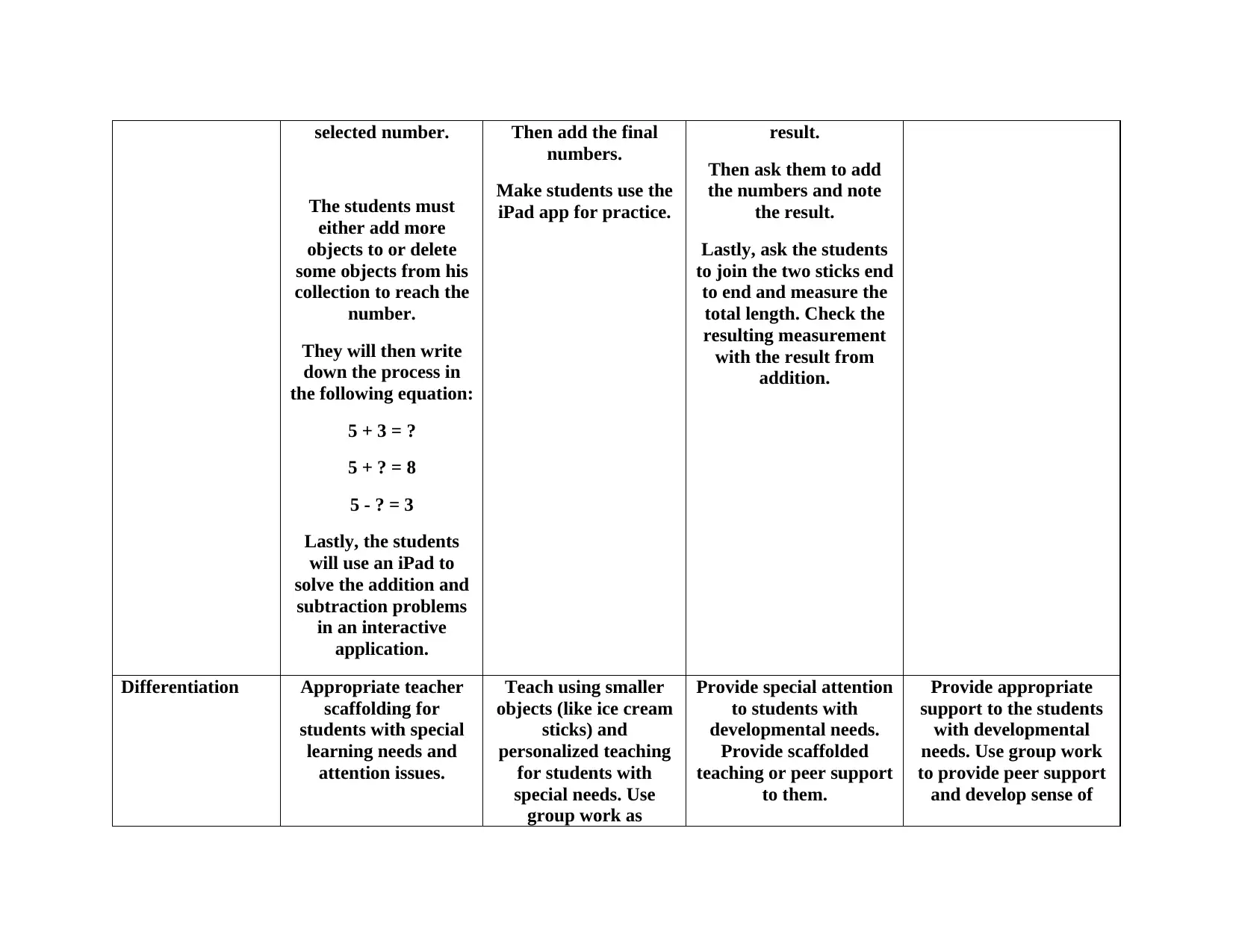
selected number.
The students must
either add more
objects to or delete
some objects from his
collection to reach the
number.
They will then write
down the process in
the following equation:
5 + 3 = ?
5 + ? = 8
5 - ? = 3
Lastly, the students
will use an iPad to
solve the addition and
subtraction problems
in an interactive
application.
Then add the final
numbers.
Make students use the
iPad app for practice.
result.
Then ask them to add
the numbers and note
the result.
Lastly, ask the students
to join the two sticks end
to end and measure the
total length. Check the
resulting measurement
with the result from
addition.
Differentiation Appropriate teacher
scaffolding for
students with special
learning needs and
attention issues.
Teach using smaller
objects (like ice cream
sticks) and
personalized teaching
for students with
special needs. Use
group work as
Provide special attention
to students with
developmental needs.
Provide scaffolded
teaching or peer support
to them.
Provide appropriate
support to the students
with developmental
needs. Use group work
to provide peer support
and develop sense of
The students must
either add more
objects to or delete
some objects from his
collection to reach the
number.
They will then write
down the process in
the following equation:
5 + 3 = ?
5 + ? = 8
5 - ? = 3
Lastly, the students
will use an iPad to
solve the addition and
subtraction problems
in an interactive
application.
Then add the final
numbers.
Make students use the
iPad app for practice.
result.
Then ask them to add
the numbers and note
the result.
Lastly, ask the students
to join the two sticks end
to end and measure the
total length. Check the
resulting measurement
with the result from
addition.
Differentiation Appropriate teacher
scaffolding for
students with special
learning needs and
attention issues.
Teach using smaller
objects (like ice cream
sticks) and
personalized teaching
for students with
special needs. Use
group work as
Provide special attention
to students with
developmental needs.
Provide scaffolded
teaching or peer support
to them.
Provide appropriate
support to the students
with developmental
needs. Use group work
to provide peer support
and develop sense of
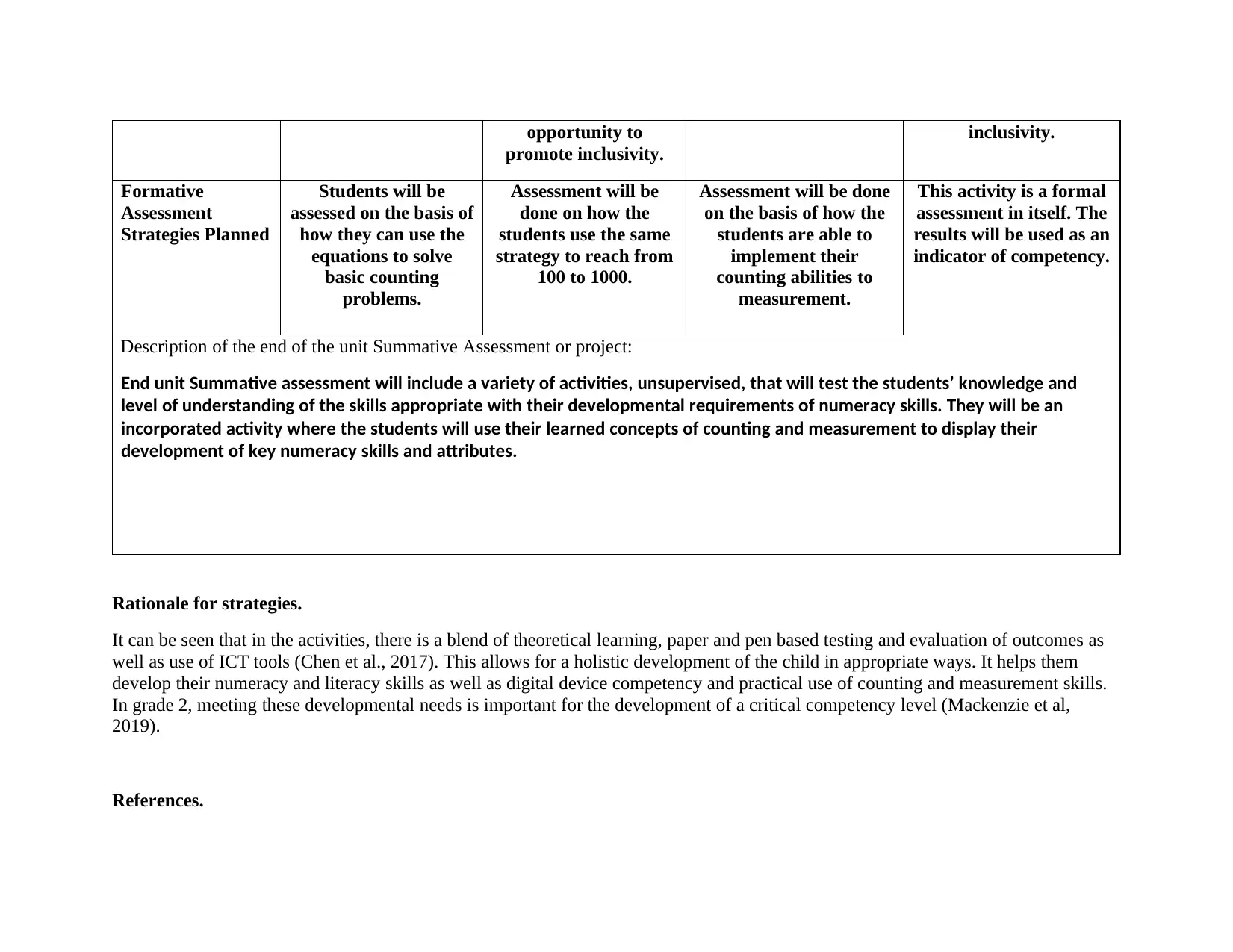
opportunity to
promote inclusivity.
inclusivity.
Formative
Assessment
Strategies Planned
Students will be
assessed on the basis of
how they can use the
equations to solve
basic counting
problems.
Assessment will be
done on how the
students use the same
strategy to reach from
100 to 1000.
Assessment will be done
on the basis of how the
students are able to
implement their
counting abilities to
measurement.
This activity is a formal
assessment in itself. The
results will be used as an
indicator of competency.
Description of the end of the unit Summative Assessment or project:
End unit Summative assessment will include a variety of activities, unsupervised, that will test the students’ knowledge and
level of understanding of the skills appropriate with their developmental requirements of numeracy skills. They will be an
incorporated activity where the students will use their learned concepts of counting and measurement to display their
development of key numeracy skills and attributes.
Rationale for strategies.
It can be seen that in the activities, there is a blend of theoretical learning, paper and pen based testing and evaluation of outcomes as
well as use of ICT tools (Chen et al., 2017). This allows for a holistic development of the child in appropriate ways. It helps them
develop their numeracy and literacy skills as well as digital device competency and practical use of counting and measurement skills.
In grade 2, meeting these developmental needs is important for the development of a critical competency level (Mackenzie et al,
2019).
References.
promote inclusivity.
inclusivity.
Formative
Assessment
Strategies Planned
Students will be
assessed on the basis of
how they can use the
equations to solve
basic counting
problems.
Assessment will be
done on how the
students use the same
strategy to reach from
100 to 1000.
Assessment will be done
on the basis of how the
students are able to
implement their
counting abilities to
measurement.
This activity is a formal
assessment in itself. The
results will be used as an
indicator of competency.
Description of the end of the unit Summative Assessment or project:
End unit Summative assessment will include a variety of activities, unsupervised, that will test the students’ knowledge and
level of understanding of the skills appropriate with their developmental requirements of numeracy skills. They will be an
incorporated activity where the students will use their learned concepts of counting and measurement to display their
development of key numeracy skills and attributes.
Rationale for strategies.
It can be seen that in the activities, there is a blend of theoretical learning, paper and pen based testing and evaluation of outcomes as
well as use of ICT tools (Chen et al., 2017). This allows for a holistic development of the child in appropriate ways. It helps them
develop their numeracy and literacy skills as well as digital device competency and practical use of counting and measurement skills.
In grade 2, meeting these developmental needs is important for the development of a critical competency level (Mackenzie et al,
2019).
References.
⊘ This is a preview!⊘
Do you want full access?
Subscribe today to unlock all pages.

Trusted by 1+ million students worldwide
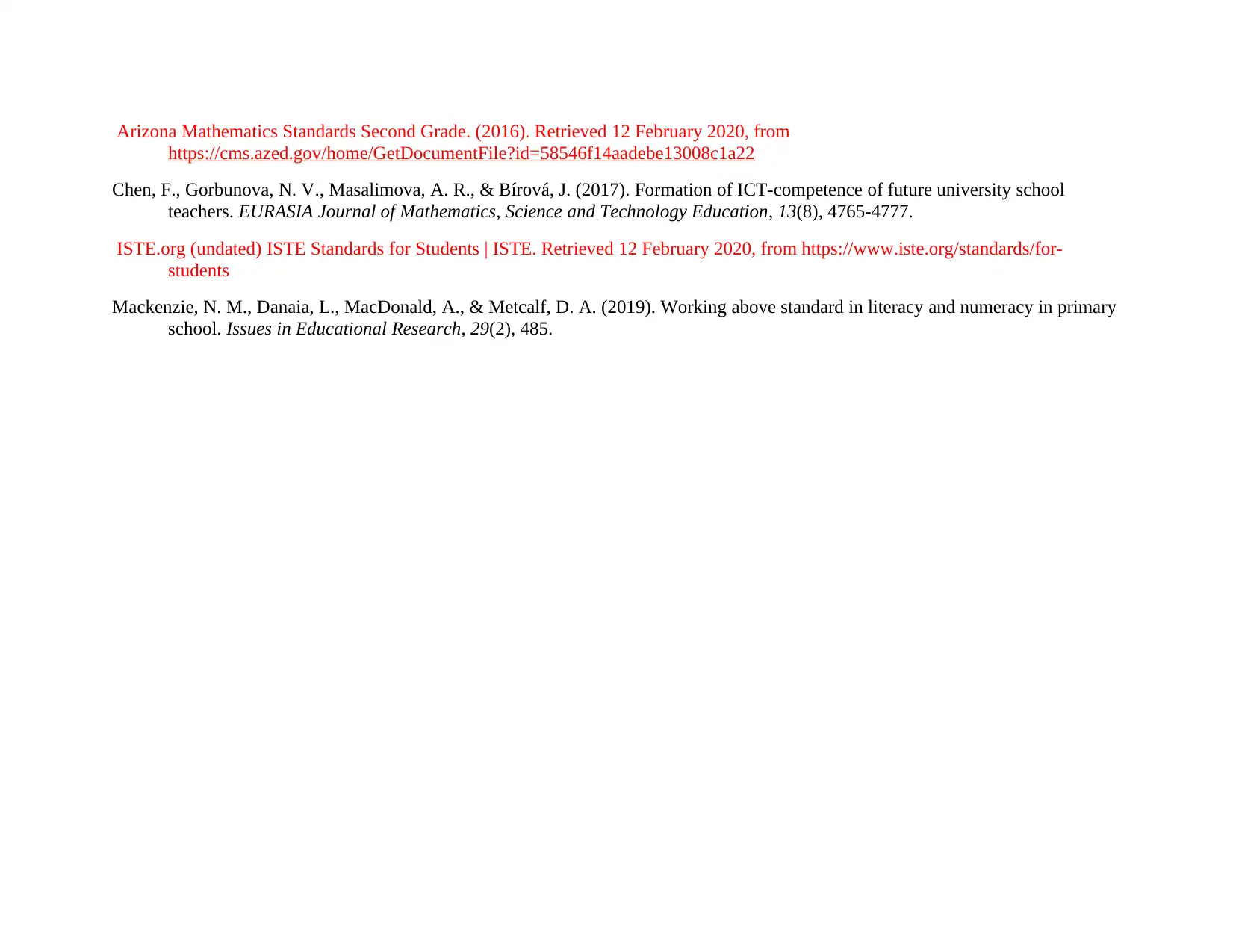
Arizona Mathematics Standards Second Grade. (2016). Retrieved 12 February 2020, from
https://cms.azed.gov/home/GetDocumentFile?id=58546f14aadebe13008c1a22
Chen, F., Gorbunova, N. V., Masalimova, A. R., & Bírová, J. (2017). Formation of ICT-competence of future university school
teachers. EURASIA Journal of Mathematics, Science and Technology Education, 13(8), 4765-4777.
ISTE.org (undated) ISTE Standards for Students | ISTE. Retrieved 12 February 2020, from https://www.iste.org/standards/for-
students
Mackenzie, N. M., Danaia, L., MacDonald, A., & Metcalf, D. A. (2019). Working above standard in literacy and numeracy in primary
school. Issues in Educational Research, 29(2), 485.
https://cms.azed.gov/home/GetDocumentFile?id=58546f14aadebe13008c1a22
Chen, F., Gorbunova, N. V., Masalimova, A. R., & Bírová, J. (2017). Formation of ICT-competence of future university school
teachers. EURASIA Journal of Mathematics, Science and Technology Education, 13(8), 4765-4777.
ISTE.org (undated) ISTE Standards for Students | ISTE. Retrieved 12 February 2020, from https://www.iste.org/standards/for-
students
Mackenzie, N. M., Danaia, L., MacDonald, A., & Metcalf, D. A. (2019). Working above standard in literacy and numeracy in primary
school. Issues in Educational Research, 29(2), 485.
1 out of 7
Related Documents
Your All-in-One AI-Powered Toolkit for Academic Success.
+13062052269
info@desklib.com
Available 24*7 on WhatsApp / Email
![[object Object]](/_next/static/media/star-bottom.7253800d.svg)
Unlock your academic potential
Copyright © 2020–2025 A2Z Services. All Rights Reserved. Developed and managed by ZUCOL.




